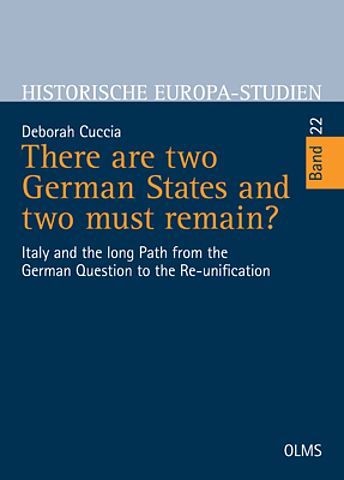Cuccia
There are two German States and two must remain?
ISBN 978-3-487-15810-5
In the night of 9 November the images of thousands of Eastern Germans pouring into Berlin security checkpoints at Bernauerstraße and West Berliners knocking the first brick out of the Wall literally travelled around the world. More than any other frontier, the division of Berlin as its physical representation epitomized in people’s mind the ultimate sign of the division of Europe into spheres of influence. More than any other event in Central Eastern Europe, the Berlin Wall’s demolition contributed to reshape both geographical maps and ideological camps.
It is, therefore, not in the least surprising that these events captured the attention of millions of Europeans, ranging from present-day observers to prominent experts. Still, throughout the years, the main research focus has been either on the inner German dynamics or on the role played by the Superpowers. With the 30th anniversary of the fall of the Wall in the offing and an apparent creeping estrangement between Italy and Germany making the front page, the time is ripe for providing deeper insights into the reactions arising in Italy from the German events.
How did the Italian vision of the German Question evolve? How did Rome perceive and react to the process leading to German unity? What kind of tools had the European integration process and the evolution of the Italian-German relations? How did Rome cope with the challenge issued by this “acceleration of history”? In answering these questions, the book goes far beyond the limitations imposed by a traditional diplomatic and foreign policy approach, embracing also the economic and cultural levels, as well as the mass media. The year 1989 was a test of the level of maturity attained by the Italian-German couple, which casts a long shadow that goes far beyond their respective national borders.
In der Nacht des 9. November gingen die Bilder von Tausenden von Ostdeutschen, die in die Sicherheitskontrollen in der Bernauerstraße strömten, und von Westberlinern, die den ersten Stein aus der Mauer schlugen, buchstäblich um die Welt. Mehr als jede andere Grenze verkörperte die Teilung Berlins in den Köpfen der Menschen das ultimative Zeichen für die Aufteilung Europas in Einflusssphären. Mehr als jedes andere Ereignis in Ostmitteleuropa trug der Fall der Berliner Mauer dazu bei, sowohl die geografischen Karten als auch die ideologischen Lager neu zu gestalten.
Es ist daher nicht im Geringsten überraschend, dass diese Ereignisse die Aufmerksamkeit von Millionen von Europäern auf sich zogen, von heutigen Beobachtern bis hin zu prominenten Experten. Dennoch lag das Hauptaugenmerk der Forschung über die Jahre hinweg entweder auf der innerdeutschen Dynamik oder auf der Rolle der Supermächte. Jahrestag des Mauerfalls bevorsteht und eine scheinbar schleichende Entfremdung zwischen Italien und Deutschland die Schlagzeilen beherrscht, ist die Zeit reif für tiefere Einblicke in die Reaktionen, die in Italien auf die deutschen Ereignisse entstanden sind.
Wie hat sich die italienische Sicht der deutschen Frage entwickelt? Wie hat Rom den Prozess, der zur deutschen Einheit führte, wahrgenommen und darauf reagiert? Welches Instrumentarium hatten der europäische Integrationsprozess und die Entwicklung der deutsch-italienischen Beziehungen? Wie ging Rom mit der Herausforderung um, die diese "Beschleunigung der Geschichte" darstellte? Bei der Beantwortung dieser Fragen geht das Buch weit über die Grenzen eines traditionellen diplomatischen und außenpolitischen Ansatzes hinaus und bezieht auch die wirtschaftliche und kulturelle Ebene sowie die Massenmedien ein. Das Jahr 1989 war ein Test für den Reifegrad des deutsch-italienischen Paares, der einen langen Schatten wirft, der weit über die jeweiligen Landesgrenzen hinausgeht.


